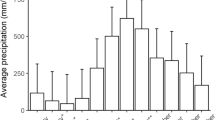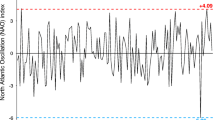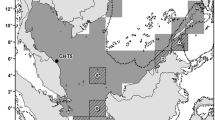Abstract
Sea turtles are migratory animals that travel from foraging grounds to specific nesting beaches every few years and that, therefore, can be influenced by oceanographic conditions in several different habitats. We assessed how sea surface temperature (SST) and chlorophyll-α (Chl-α) within both internesting and foraging areas influence the nesting abundance, phenology and duration of internesting periods of the green turtles (Chelonia mydas) that nest at Cabuyal, Northwest Costa Rica. Specifically, we compared (1) SST and Chl-α in foraging areas to the nesting abundance and median nesting date (MND) registered on the beach over seven nesting seasons and (2) SST in internesting habitats to the observed internesting period (OIP) (number of days between successful nesting events) and the MND. Nesting abundance was strongly correlated to Chl-α concentrations at the main foraging area during the February preceding the nesting season. However, we found no significant effect of SST or Chl-α in either foraging or internesting habitats on the MND. Mean SST values in the internesting habitats and OIP were negatively correlated and were highly variable both between and within years. Oceanographic conditions appear to strongly influence OIP and nesting abundance, but not the nesting phenology of green turtles in this area. The complex nature of the effect of oceanographic conditions on reproduction of the East Pacific green turtle suggests uncertainty in how this species will respond to climate change.




Similar content being viewed by others
References
Alfaro EJ, Cortés J (2012) Atmospheric forcing of cool subsurface water events in Bahía Culebra, Gulf of Papagayo, Costa Rica. Rev Biol Trop 60:173–186
Almpanidou V, Katragkou E, Mazaris AD (2018) The efficiency of phenological shifts as an adaptive response against climate change: a case study of loggerhead sea turtles (Caretta caretta) in the Mediterranean. Mitig Adapt Strateg Glob Change 23(7):1143–1158
Alvarado-Díaz J, Arias-Coyotl E, Delgado-Trejo C (2003) Clutch frequency of the Michoacán green sea turtle. J Herpetol 37:183–185. https://doi.org/10.1670/0022-1511(2003)037%5b0183:CFOTMN%5d2.0.CO;2
Angeles-Gonzalez LE, Calva R, Santos-Valencia J, Avila-Poveda OH, Olivares A, Diaz F, Rosas C (2017) Temperature modulates spatio-temporal variability of the functional reproductive maturation of Octopus maya (Cephalopoda) on the shelf of the Yucatan Peninsula, Mexico. J Molluscan Stud 83:280–288. https://doi.org/10.1093/mollus/eyx013
Bates AE, Helmuth B, Burrows MT, Duncan MI, Garrabou J, Guy-Haim T, Lima F, Queiros AM, Seabra R, Marsh R, Belmaker J, Bensoussan N, Dong Y, Mazaris AD, Smale D, Wahl M, Rilov G (2018) Biologists ignore ocean weather at their peril. Nature 506:299–301
Blanco GS, Morreale SJ, Bailey H, Seminoff JA, Paladino FV, Spotila JR (2012) Post-nesting movements and feeding grounds of a resident East Pacific green turtle Chelonia mydas population from Costa Rica. Endanger Species Res 18:233–245. https://doi.org/10.3354/esr00451
Both C, Van Asch M, Bijlsma RG, Van Den Burg AB, Visser ME (2009) Climate change and unequal phenological changes across four trophic levels: constraints or adaptations? J Anim Ecol 78:73–83. https://doi.org/10.1111/j.1365-2656.2008.01458.x
Brenes CL (2001) Fundamentos de oceanografia descriptiva: aplicaciones al istmo centroamericano. Proyecto para el Desarrollo Integral de la Pesca Artesanal en la Region Autónoma Atlántico Sur (DIPAL), Nicaragua
Broderick AC, Godley BJ, Hays GC (2001) Trophic status drives interannual variability in nesting numbers of marine turtles. Proc R Soc Lond B Biol Sci 268:1481–1487. https://doi.org/10.1098/rspb.2001.1695
Broderick AC, Glen F, Godley BJ, Hays GC (2002) Estimating the number of green and loggerhead turtles nesting annually in the Mediterranean. Oryx 36:227–235. https://doi.org/10.1670/0022-1511(2003)037%5b0183:CFOTMN%5d2.0.CO;2
Chaloupka M, Kamezaki N, Limpus CJ (2008) Is climate change affecting the population dynamics of the endangered Pacific loggerhead sea turtle? J Exp Mar Bio Ecol 356:136–143. https://doi.org/10.1016/j.jembe.2007.12.009
Cheng I (2000) Post-nesting migrations of green turtles (Chelonia mydas) at Wan-An Island, Penghu Archipelago, Taiwan. Mar Biol 137:747–754
Clyde-Brockway CE (2014) Inter-nesting and post-nesting movements and behaviour of East Pacific Green turtles (Chelonia mydas agassizii) from playa Cabuyal, Guanacaste, Costa Rica. Master thesis, Purdue University, Indiana
Edwards M, Richardson AJ (2004) Impact of climate change on marine pelagic phenology and trophic mismatch. Nature 430:881–884
Fiedler PC (2002) The annual cycle and biological effects of the Costa Rica Dome. Deep Sea Res 49:321–338
Glynn PW, Druffel EM, Dunbar RB, Glynn Peter, Druffel EM, Dunbar RB (1983) A dead Central American coral reef tract: possible link with the Little Ice Age. J Mar Res 41:605–637. https://doi.org/10.1357/002224083788519740
Godley BJ, Broderick AC, Frauenstein R, Glen F, Hays GC (2002) Reproductive seasonality and sexual dimorphism in green turtles. Mar Ecol Prog Ser 226:125–133
Hamann M, Limpus CJ, Owens DW (2003) Reproductive cycles of males and females. In: Lutz PL, Musick JA, Wyneken J (eds) The biology of sea turtles, vol 2. CRC Press, Florida, pp 135–161
Hart CE, Blanco GS, Coyne MS, Delgado-Trejo C, Godley BJ, Todd Jones T, Resendiz A, Seminoff JA, Witt MJ, Nichols WJ (2015) Multinational tagging efforts illustrate regional scale of distribution and threats for east pacific green turtles (Chelonia mydas agassizii). PLoS ONE. https://doi.org/10.1371/journal.pone.0116225
Hays GC, Broderick AC, Glen F, Godley BJ, Houghton JDR, Metcalfe JD (2002) Water temperature and internesting intervals for loggerhead (Caretta caretta) and green (Chelonia mydas) sea turtles. J Therm Biol 27:429–432
Hirth HF (1980) Some aspects of the nesting behavior and reproductive biology of sea turtles. Am Zool 20:507–523
IBM Corp (2015) IBM SPSS Statistics for Windows
Lamont MM, Fujisaki I (2014) Effects of ocean temperature on nesting phenology and fecundity of the loggerhead sea turtle (Caretta caretta). Artic J Herpetol 48:98–102. https://doi.org/10.1670/12-217
Limpus CJ, Hamann M, Whittier JM (2002) Patterns of lipid storage and mobilisation in female green sea turtles (Chelonia mydas). Artic J Comp Physiol B 172:485–493. https://doi.org/10.1007/s00360-002-0271-2
Mazaris AD, Kallimanis AS, Sgardelis SP, Pantis JD (2008) Do long-term changes in sea surface temperature at the breeding areas affect the breeding dates and reproduction performance of Mediterranean loggerhead turtles? Implications for climate change. Exp Mar Biol Ecol 367:219–226. https://doi.org/10.1016/j.jembe.2008.09.025
Mazaris AD, Kallimanis AS, Tzanopoulos J, Sgardelis SP, Pantis JD (2009) Sea surface temperature variations in core foraging grounds drive nesting trends and phenology of loggerhead turtles in the Mediterranean Sea. Exp Mar Biol Ecol 379:23–27. https://doi.org/10.1016/j.jembe.2009.07.026
Mazaris AD, Kallimanis AS, Pantis JD, Hays GC (2013) Phenological response of sea turtles to environmental variation across a species’ northern range. Proc R Soc B Biol Sci 280:20122397. https://doi.org/10.1098/rspb.2012.2397
Monticelli D, Ramos JA, Catry T, Pedro P, Paiva VH (2014) Reproductive parameters of tropical lesser noddies respond to local variations in oceanographic conditions and weather. Estuar Coast Shelf Sci 139:110–118. https://doi.org/10.1016/j.ecss.2013.12.026
Neeman N, Robinson NJ, Paladino FV, Spotila JR, Connor MPO (2015) Phenology shifts in leatherback turtles (Dermochelys coriacea) due to changes in sea surface temperature. J Exp Mar Bio Ecol 462:113–120. https://doi.org/10.1016/j.jembe.2014.10.019
Patel SH, Morreale SJ, Saba VS, Panagopoulou A, Margaritoulis D, Spotila JR (2016) Climate impacts on sea turtle breeding phenology in Greece and associated foraging habitats in the wider Mediterranean region. PLoS ONE 11:157170. https://doi.org/10.1371/journal.pone.0157170
Pike DA (2009) Do green turtles modify their nesting seasons in response to environmental temperatures? Chelonian Conserv Biol 8:43–47. https://doi.org/10.2744/CCB-0726.1
Pike DA, Antworth RL, Stiner JC (2006) Earlier nesting contributes to shorter nesting seasons for the loggerhead sea turtle, Caretta caretta. J Herpetol 40:91–94. https://doi.org/10.1670/100-05N.1
Polovina JJ, George H, Howell EA, Denise M, Seki MP, Peter H (2004) Forage and migration habitat of loggerhead (Caretta caretta) and olive ridley (Lepidochelys olivacea) sea turtles in the central North Pacific Ocean. Fish Oceanogr 13:36–51
Potts WM, Booth AJ, Richardson TJ, Sauer WHH (2014) Ocean warming affects the distribution and abundance of resident fishes by changing their reproductive scope. Rev Fish Biol Fish 24:493–504. https://doi.org/10.1007/s11160-013-9329-3
Quiñones J, González Carman V, Zeballos J, Purca S, Mianzan H (2010) Effects of El Niño-driven environmental variability on black turtle migration to Peruvian foraging grounds. Hydrobiologia 645:69–79. https://doi.org/10.1007/s10750-010-0225-8
Reina RD, Mayor PA, Spotila JR, Piedra R, Paladino FV (2002) Nesting ecology of the leatherback turtle, Dermochelys coriacea, at Parque Nacional Marino Las Baulas, Costa Rica: 1988–1989 to 1999–2000. Copeia 2002:653–664
Robinson NJ, Valentine SE, Santidrián Tomillo P, Saba VS, Spotila JR, Paladino FV (2014) Multidecadal trends in the nesting phenology of Pacific and Atlantic leatherback turtles are associated with population demography. Endanger Species Res 24:197–206. https://doi.org/10.3354/esr00604
Robinson NJ, Paladino FV, Santidrián Tomillo P (2017) Evidence of a green turtle starting its postnesting migration without laying all its vitellogenic follicles. Mar Turt Newsl 152:8–10
Saba VS, Santidrián Tomillo P, Reina RD, Spotila JR, Musick JA, Evans DA, Paladino FV (2007) The effect of the El Niño Southern Oscillation on the reproductive frequency of eastern Pacific leatherback turtles. J Appl Ecol 44:395–404. https://doi.org/10.1111/j.1365-2664.2007.01276.x
Santidrián Tomillo P, Roberts SA, Hernández R, Spotila JR, Paladino FV (2015) Nesting ecology of East Pacific green turtles at Playa Cabuyal, Gulf of Papagayo, Costa Rica. Mar Ecol 36:506–516. https://doi.org/10.1111/maec.12159
Santidrián Tomillo P, Fonseca L, Paladino FV, Spotila JR, Oro D (2017) Are thermal barriers “higher” in deep sea turtle nests? PLoS ONE 12:e0177256. https://doi.org/10.1371/journal.pone.0177256
Sato K, Matsuzawa Y, Tanaka H, Bando T, Minnamikawa S, Sakamoto W, Naito Y (1998) Internesting intervals for loggerhead turtles, Caretta caretta, and green turtles, Chelonia mydas, are affected by temperature. Can J Zool 9:1651
Schofield G, Bishop CM, Katselidis KA, Dimopoulos P, Pantis JD, Hays GC (2009) Microhabitat selection by sea turtles in a dynamic thermal marine environment. J Anim Ecol 78:14–21. https://doi.org/10.1111/j.1365-2656.2007.0
Seminoff JA, Resendiz A, Nichols W (2002) Diet of east Pacific green turtles (Chelonia mydas) in the central Gulf of California, Mexico. J Herpetol 36:447–453
Seminoff JA, Zárate P, Coyne M, Foley DG, Parker D, Lyon BN, Dutton PH (2008) Post-nesting migrations of Galápagos green turtles Chelonia mydas in relation to oceanographic conditions: integrating satellite telemetry with remotely sensed ocean data. Endanger Species Res 4:57–72. https://doi.org/10.3354/esr00066
Solow AR, Bjorndal KA, Bolten AB (2002) Annual variation in nesting numbers of marine turtles: the effect of sea surface temperature on re-migration intervals. Ecol Lett 5:742–746. https://doi.org/10.1046/j.1461-0248.2002.00374.x
Vander Zanden HB, Pfaller JB, Reich KJ, Pajuelo M, Bolten AB, Williams KL, Frick MG, Shamblin BM, Campbell NJ, Bjorndal KA (2014) Foraging areas differentially affect reproductive output and interpretation of trends in abundance of loggerhead turtles. Mar Biol 161:585–598. https://doi.org/10.1007/s00227-013-2361-y
Weishampel JF, Bagley DA, Ehrhart LM (2004) Earlier nesting by loggerhead sea turtles following sea surface warming. Glob Chang Biol 10:1424–1427. https://doi.org/10.1111/j.1365-2486.2004.00817.x
Weishampel JF, Bagley DA, Ehrhart LM, Weishampel AC (2010) Nesting phenologies of two sympatric sea turtle species related to sea surface temperatures. Endangered Species Res 12:41–47. https://doi.org/10.3354/esr00290
Acknowledgements
We would like to thank the research teams that have helped year after year to collect field nesting data at Cabuyal. This research would have been impossible without the hard work of coordinators, research assistants and volunteers. We also thank Roger Blanco and the Guanacaste Conservation Area for granting scientific permits and for their genuine interest in research. We thank Alejandro Martínez Abraín for statistical advice. Finally, we would like to thank the reviewers that helped improved the quality of the study.
Funding
This study was funded by The Leatherback Trust.
Author information
Authors and Affiliations
Corresponding author
Ethics declarations
Conflict of interest
All authors declare that they have no conflicts of interests.
Ethical approval
All applicable international, national, and/or institutional guidelines for the care and use of animals were followed. Research permits were obtained by the Ministry of Environment and Energy of Costa Rica (MINAE).
Additional information
Responsible Editor: P. Casale.
Publisher's Note
Springer Nature remains neutral with regard to jurisdictional claims in published maps and institutional affiliations.
Reviewed by J. Bourjea, A. Mazaris and J. Weishampel.
Electronic supplementary material
Below is the link to the electronic supplementary material.
Rights and permissions
About this article
Cite this article
Valverde-Cantillo, V., Robinson, N.J. & Santidrián Tomillo, P. Influence of oceanographic conditions on nesting abundance, phenology and internesting periods of east Pacific green turtles. Mar Biol 166, 93 (2019). https://doi.org/10.1007/s00227-019-3541-1
Received:
Accepted:
Published:
DOI: https://doi.org/10.1007/s00227-019-3541-1




